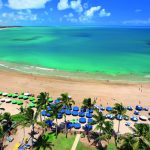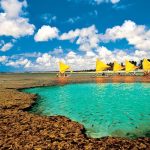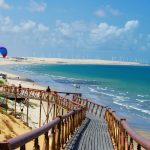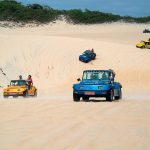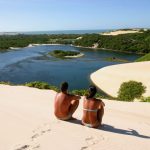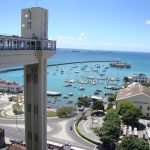It is the largest region in the country, with nine states (Alagoas, Bahia, Ceará, Maranhão, Paraíba, Piauí, Pernambuco, Rio Grande do Norte and Sergipe, that concetrates the most beaches of the Brazilian coast.
Perfect for: Families, couples and youth groups.
Best Time: September through June for the main cities. The Carnival in Salvador has been attracting people from all of the world. In January it is celebrated the ceremony of washing the stairs of the Bonfim church (Salvador). In Fortaleza, in the last week of July there is the “Fortal” (Carnival out of season). From June to the second week of August, in São Luis, the famous Bumba Meu Boi festival. Lençois Maranhenses is a must and shall be visited between March and September. The Carnival in Olinda and Recife are very popular with street bands through the cities.
Bahia:
Chapada Diamantina: It is a wooded oasis in the dusty “sertão”, with old diamond mining towns and great hiking programs. The small town of Lençois offers the largest options of lodges, restaurants and is the start point for expeditions to the caves.
Ilheus/Itacaré: Ilhéus is the port where Jorge Amado (Brazil’s best known novelist) inspired to write the main novels. It has a colonial center and beautiful beaches in the direction to Itacaré (76km. to the south) a charming beach place with a geographical contrast with the rest of the state coast, with rain forest vegetation and heavy waves. The village breathes surf, capoeira (Brazilian martial arts), reggae and forró.
Península do Maraú: Peace and tranquility are found here. One of the furthest beaches in the whole country, accessible only by boat or by air.
Praia do Forte: An Ecological beach resort in the district of Mata de São João. It is well organized and a charming village in almost every aspects: hotels, resorts, restaurants, shops, vibrant nightlife, fine beaches, ruined fortress and the sea turtle reserve, the Tamar project.
Salvador: Salvador da Bahia is the capital of Bahia state and one of Brazil’s cultural highlights. This city retains its African soul with a unique and vibrant culture. In Salvador , black people preserved their African culture and it is reflected everywhere (religion, food, music, capoeira – martial-art). Its exuberant monuments deserves a careful and attentive visit . Pelourinho the best known district in the historic center was recovered its former splendor. Colonial mansions were restored giving room for bars, restaurants and hotels. The temples are the pride of the city, people says there are more than 360 of them, one for each day. Bahia’s most popular church, however, is that of Senhor do Bonfim.
Sauipe: Costa do Sauipe lodges a rich resort infrastructure comprising five mega hotels that cater to couple in honey moon, family with children, business conventions or youths in search of wild partying.
Ceará:
Fortaleza: Fortaleza, the capital of the state, is a fishing port and commercial center with a small historic section and an active beach nightlife scene. Coming to Fortaleza you have the chance to enjoy special beaches and the raftsmen’s heroic life. There is always plenty of sunshine along the coast from where one can watch the coming and going of rafts on the green sea. It is located by the sea and between two rivers, its climate is pleasant everyday of the year. In Fortaleza one will feel as if one were in a party whose hostess is the charming sweet city. Fortaleza is the kind of city that can be busy and cozy at the same time. No matter where one is – swimming at Praia do Futuro (Beach of the Future), sunbathing at Porto das Dunas (Dune Port) or watching the sunset at Cumbuco – there is always something to enjoy.
Jericoacoara: Sunshine, beaches, lovely lagoons, soft breeze and tropical climate. This small fishing village, 290km. northwest of Fortaleza, not accessible on a regular car, but by 4×4 vehicles, it is one of Brazil’s most remote beaches. Popular with packers, hip Brazilians and windsurfers is a beautiful and unique place that has a rustic but charming character. You can climb dunes, hire horse, sail on jangada or walk to Pedra Furada.
Maranhão:
Lençois Maranhenses: It is a 252km. away from São Luís, ride to Barreirinhas, the village that gives access to the Lençois Maranhenses National Park. The landscape of dunes and transparent water lagoons is 70km. wide advancing up to 50km. into the mainland, the name Lençois is because of the immense dunes that look like bed sheets (Lençois in Portuguese). There nature lovers may choose to travel by jeep or 4×4 vehicles over the long sand strip or by boat on the Preguiças river, admiring the innumerable dunes.
São Luis do Maranhão: The state’s capital, São Luis, lodges one of the most impressive architectural heritages in the country. Portuguese and Frenchs settlers left behind more than three thousand buildings among which 1.100 are currently classified as World Heritage, the colonial center is one of the architectural highlights of Brazil.
Pernambuco:
Fernando de Noronha Island: This archipelago is definitely one of the most beautiful places in the entire country. The excellent underwater visibility and wealthy of fauna has given it wide renown as a diver’s paradise. Above the surface are some of the most beautiful beaches of Brazil, like Bapia do Sancho, Baía dos Porcos and do Leão.
Olinda: Beautiful Olinda, only 7 km away from Recife, sits on a hill overlooking Recife and the Atlantic Ocean. One of Brazils best preserved colonial cities with buildings from the 16th and 17th centuries, protected by Unesco as World Heritage, its filled with artists, students and bohemians and has some charming accomodations.
Porto de Galinhas: Just 81km south of the capital of Pernambuco, Porto de Galinhas has become an up scale resort center and a base for irresistible tours: everyone goes there to see the natural pools of transparent waters full of lively little fishes. Then at sunset, after beach time, the excitement moves over to the small shops, bars and restaurants that fill the boardwalk.
Recife: Recife is not one city, but two. In the first one, what is important are the beaches. There are 12 km of sand, palm trees and jangada-rafts, divided between Boa Viagem and Pina. Here the principal hotels are located and a big concentration of tourists. The name Recife means reef and comes from the rock formations which protects the beaches. To get to the other Recife, one has to cross the bridges over the Capibaribe and Beberibe rivers. This part of Recife is much older, from the 17:th century and its principal attractions are the historical buildings (fortresses, monasterys, houses and churches) and true arquitectual relics such as the Fort of Brum and the Golden Chapel. Recife’s colonial-style buildings relive the past, the wars against foreign invaders and the struggle for political freedom.
Rio Grande do Norte:
Natal: Capital of the Rio Grande do Norte state, known as the City of the Sun. Located in the easternmost point of the continent, Natal has a gentle breeze that blows from the ocean and white sands beaches lined with palms and natural swimming-pools because of the reef barriers. Highlights of a visit to Natal are Reis Magos Fortress, built by the Portuguese in 1598 and Natal’s first building; Centro de Turismo (Tourism Center) a 19th Century neo-classical building that houses today a handicraft center and art gallery; Rosario Church built in 1714. Natal is famous for its beaches and moving dunes: a few names: Praia do Meio, Praia dos Artstas, Praia de Areia Preta, Praia de Ponta Negra. To the south: Cotovelo, Piranji do Norte, Piranji do Sul, Búzios, Barra de Tabatinga, Barreta and Pipa. To the north: Redinha, Redinha Nova, Santa Rita, Genipabu, Pitangui, Jacumã, Muriú, Barra de Maxanranguape and Praia de Touros.
Pipa: At Rio Grande do Norte it has dozens of great beaches, but the most attractive spot of all is the famous Praia da Pipa, usually catering to three different groups of people (surfers, nature lovers and party hunters). Pipa is small, clean plenty of pousadas, boutiques, restaurants and bars, indeed Pipa offers a mix of rough waves and an ecological refuge for dolphins at Formosa bay.

